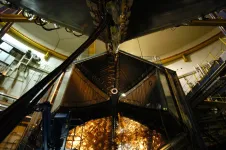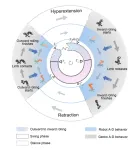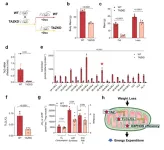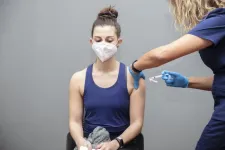It’s a result that has been decades in the making. The dataset was originally collected in 2004. Lamiaa El Fassi, now an associate professor of physics at Mississippi State University and principal investigator of the work, first analyzed these data during her thesis project to earn her graduate degree on a different topic.
Nearly a decade after completing her initial research with these data, El Fassi revisited the dataset and led her group through a careful analysis to yield these unprecedented measurements. The dataset comes from experiments in Jefferson Lab’s Continuous Electron Beam Accelerator Facility (CEBAF), a DOE user facility. In the experiment, nuclear physicists tracked what happened when electrons from CEBAF scatter off the target nucleus and probe the confined quarks inside protons and neutrons. The results were recently published in Physical Review Letters.
“These studies help build a story, analogous to a motion picture, of how the struck quark turns into hadrons. In a new paper, we report first-ever observations of such a study for the lambda baryon in the forward and backward fragmentation regions,” El Fassi said.
In like a lambda, out like a pion
Like the more familiar protons and neutrons, each lambda is made up of three quarks.
Unlike protons and neutrons, which only contain a mixture of up and down quarks, lambdas contain one up quark, one down quark and one strange quark. Physicists have dubbed matter that contains strange quarks “strange matter.”
In this work, El Fassi and her colleagues studied how these particles of strange matter form from collisions of ordinary matter. To do so, they shot CEBAF’s electron beam at different targets, including carbon, iron, and lead. When a high-energy electron from CEBAF reaches one of these targets, it breaks apart a proton or neutron inside one of the target’s nuclei.
“Because the proton or neutron is totally broken apart, there is little doubt that the electron interacts with the quark inside,” El Fassi said.
After the electron interacts with a quark or quarks via an exchanged virtual photon, the “struck” quark(s) begins moving as a free particle in the medium, typically joining up with other quark(s) it encounters to form a new composite particle as they propagate through the nucleus. And some of the time, this composite particle will be a lambda.
But the lambda is short-lived – after formation, it will swiftly decay into two other particles: a pion and either a proton or neutron. To measure different properties of these briefly created lambda particles, physicists must detect its two daughter particles, as well as the beam electron that scattered off the target nucleus.
The experiment that collected this data, EG2, used the CEBAF Large Acceptance Spectrometer (CLAS) detector in Jefferson Lab’s Experimental Hall B. These recently published results, “First Measurement of Λ Electroproduction off Nuclei in the Current and Target Fragmentation Regions,” are part of the CLAS collaboration, which involves almost 200 physicists worldwide.
SIDIS
This work is the first to measure the lambda using this process, which is known as semi-inclusive deep inelastic scattering, in the forward and backward fragmentation regions. It’s more difficult to use this method to study lambda particles, because the particle decays so quickly, it can’t be measured directly.
“This class of measurement has only been performed on protons before, and on lighter, more stable particles,” said coauthor William Brooks, professor of physics at Federico Santa María Technical University and co-spokesperson of the EG2 experiment.
The analysis was so challenging, it took several years for El Fassi and her group to re-analyze the data and extract these results. It was her thesis advisor, Kawtar Hafidi, who encouraged her to pursue the investigation of the lambda from these datasets.
“I would like to commend Lamiaa’s hard work and perseverance in dedicating years of her career working on this,” said Hafidi, associate laboratory director for physical sciences and engineering at Argonne National Lab and co-spokesperson of the EG2 experiment. “Without her, this work would not have seen fruition.”
“It hasn’t been easy,” El Fassi said. “It’s a long and time-consuming process, but it was worth the effort. When you spend so many years working on something, it feels good to see it published.”
El Fassi began this lambda analysis when she herself was a postdoc, a couple of years prior to becoming an assistant professor at Mississippi State University. Along the way, several of her own postdocs at Mississippi State have helped extract these results, including coauthor Taya Chetry.
“I’m very happy and motivated to see this work being published,” said Chetry, who is now a postdoctoral researcher at Florida International University.
Two for one
A notable finding from this intensive analysis changes the way physicists understand how lambdas form in the wake of particle collisions.
In similar studies that have used semi-inclusive deep inelastic scattering to study other particles, the particles of interest usually form after a single quark was “struck” by the virtual photon exchanged between the electron beam and the target nucleus. But the signal left by lambda in the CLAS detector suggests a more packaged deal.
The authors’ analysis showed that when forming a lambda, the virtual photon has been absorbed part of the time by a pair of quarks, known as a diquark, instead of just one. After being “struck,” this diquark went on to find a strange quark and forms a lambda.
“This quark pairing suggests a different mechanism of production and interaction than the case of the single quark interaction,” Hafidi said.
A better understanding of how different particles form helps physicists in their effort to decipher the strong interaction, the fundamental force that holds these quark-containing particles together. The dynamics of this interaction are very complicated, and so is the theory used to describe it: quantum chromodynamics (QCD).
Comparing measurements to models of QCD’s predictions allows physicists to test this theory. Because the diquark finding differs from the model’s current predictions, it suggests something about the model is off.
“There is an unknown ingredient that we don’t understand. This is extremely surprising, since the existing theory can describe essentially all other observations, but not this one,” Brooks said. “That means there is something new to learn, and at the moment, we have no clue what it could be.”
To find out, they’ll need even more measurements.
Data for EG2 were collected with 5.014 GeV (billion electron-volt) electron beams in the CEBAF’s 6 GeV era. Future experiments will use electron beams from the updated CEBAF, which now extend up to 11 GeV for Experimental Hall B, as well as an updated CLAS detector known as CLAS12, to continue studying the formation of a variety of particles, including lambdas, with higher-energy electrons.
The upcoming Electron-Ion Collider (EIC) at DOE’s Brookhaven National Laboratory will also provide a new opportunity to continue studying this strange matter and quark pairing structure of the nucleon with greater precision.
“These results lay the groundwork for upcoming studies at the upcoming CLAS12 and the planned EIC experiments, where one can investigate the diquark scattering in greater detail,” Chetry said.
El Fassi is also a co-spokesperson for CLAS12 measurements of quark propagation and hadron formation. When data from the new experiments is finally ready, physicists will compare it to QCD predictions to further refine this theory.
“Any new measurement that will give novel information toward understanding the dynamics of strong interactions is very important,” she said.
By Chris Patrick
-end-
Jefferson Science Associates, LLC, manages and operates the Thomas Jefferson National Accelerator Facility, or Jefferson Lab, for the U.S. Department of Energy's Office of Science.
DOE’s Office of Science is the single largest supporter of basic research in the physical sciences in the United States and is working to address some of the most pressing challenges of our time. For more information, visit https://energy.gov/science.
END




